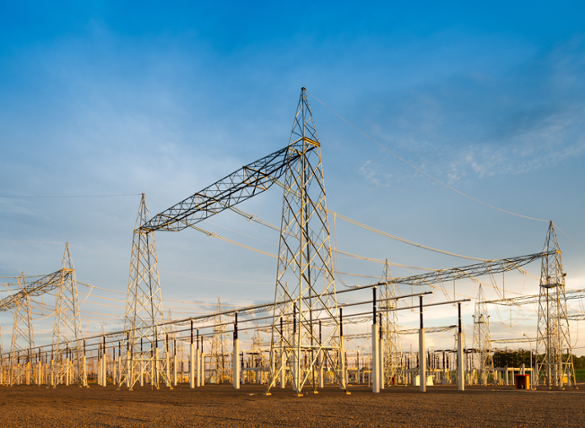Infrastructure Steady as Equities Swing
Key Takeaways
- Despite recent strong performance for listed infrastructure versus equities, infrastructure valuations are still attractive on a risk adjusted basis, with some subsector nuances.
- The outlook for utilities remains constructive and largely insulated from tariffs; electric utilities continue to secure new business tied to AI and data centre growth, particularly in North America.
- In transport, while the European airport inbound market is strongly increasing, Europe outbound to the U.S. is lower than a year ago; toll road usage continues to be robust even amid strong price hikes, highlighting the value of time savings for consumers such roads provide.
Insulated from Tariffs, Utilities Are Meeting AI Power Demand
Volatility has ticked up as a result of U.S. President Donald Trump’s reciprocal tariffs announcement on April 2: the S&P 500 Index dropped 15% intra-month from peak to trough before rebounding strongly as Trump announced a 90-day pause to allow his cabinet to negotiate trade deals with other countries.
Against this backdrop the listed infrastructure asset class has shown resilience and performed well on a relative basis prior to the recent policy reversal. The S&P Global Infrastructure Index was up 8% year to date through April versus the S&P 500’s 5% decline. This downside protection is what we would expect from listed infrastructure. Despite this strong performance, however, valuations are still attractive on a risk adjusted basis, though there are some subsector nuances that we believe are worth observing.
The outlook for utilities remains constructive and largely insulated from tariffs. Be they electric, gas or water utilities, these businesses predominantly service local catchments and do not have direct exposure to international trade. Certain components of a U.S. utility’s supply chain, such as electric components, may be sourced from overseas, but our conversations with management teams have highlighted that the exposure is relatively limited. And while utilities will continue to reconfigure their supply chain, we expect they will be able to pass through any tariff-related cost inflation to the customer via the allowed return mechanisms afforded them by regulators.
Tariffs aside, electric utilities continue to secure new business tied to AI and data centre growth, particularly in North America. Several utilities have recently announced data centre projects and related upgrades to their earnings expectations. For example, in December U.S. hyperscaler Meta Platforms announced a $10 billion data centre site in Northern Louisiana that Entergy will be building new gas-fired generation to support. Many similar opportunities and announcements have been made across a number of utilities we cover.
Exhibit 1: Announced AI Projects and Power Sources (Sample)

As of 9 May 2025. Source: ClearBridge Investments. In U.S. dollars.
The gas utility sector is also benefiting from the AI data centre theme; there is increasing recognition that gas will continue to play an important role in providing stable baseload generation for multiple decades to come, particularly as AI data centres are rolled out and call for more power. Gas pipeline companies such as TC Energy have also been expanding their networks to facilitate this demand. Beyond AI data centres, gas demand is structurally in growth mode because of increasing LNG exports and coal-to-gas switching. Oil and gas flows between Canada and the U.S. are exempt from tariffs due to the existing USMCA trade agreement.
Renewables, meanwhile, are currently awaiting clarity on a resolution regarding the fate of the U.S. renewables tax credits in the coming months as the U.S. budget reconciliation process unfolds. Our base case expectation is for a gradual winding down of the production tax credits for wind and investment tax credits for solar. But there could also be a scenario where credits are removed altogether, given the administration’s supportive stance for fossil fuel. Yet, either way, we do not expect any meaningful changes to the growth prospects for onshore wind and solar, which continue to be driven by state-based targets and economics.
GDP-Sensitive Sectors Mixed
North American freight rails saw strong volumes in the first quarter of 2025 due to the pull-forward of demand ahead of the U.S. tariffs. However, we note that shipments from China to U.S. ports have dropped more than 30% since the trade escalations in April, as of May 9. The outlook for freight for the rest of 2025 is uncertain and largely depends on how trade negotiations unfold. An early trade deal between China and the U.S. is potentially a strong positive catalyst for the sector, particularly given how beaten up valuations are currently. All else equal, however, higher tariffs than existed prior to April 2 should weigh on trade and rail volumes.
The European airport inbound market is strongly increasing with bookings in the May to June period more than 7% higher year over year. However, the outlook for the transatlantic route is mixed currently due to an aversion to travel to the U.S. While Europe-bound travel from the U.S. is pointing to 2% growth compared to last year, Europe outbound to the U.S. is currently 2% lower than a year ago.
Patronage for toll roads continues to be robust, meanwhile, driven by the inelastic demand response to considerable price hikes across key markets such as Toronto, Dallas–Fort Worth, Virginia and North Carolina. This highlights the value of time savings for consumers from using these toll roads, particularly in these congested markets.
Infrastructure Valuations and Fundamentals Are Attractive
Overall, in periods of heightened uncertainty and volatility such as the one we are in today, we expect infrastructure to exhibit resilience. With valuations currently attractive and fundamentals constructive, such resilience should only add more support to an attractive narrative for listed infrastructure.
Related Perspectives

Webinar: Power Shift | Investing in the Grid of the Future
As global electricity demand continues to surge, the need for substantial investment in power infrastructure is growing. This session explores how these shifts are shaping opportunities for global listed infrastructure, particularly within the utilities sector.
Read full article

